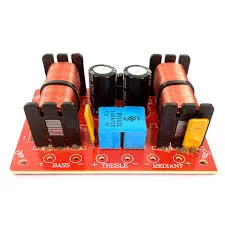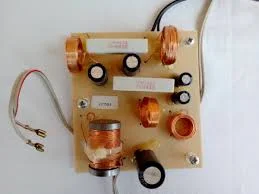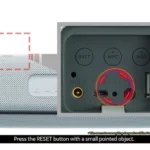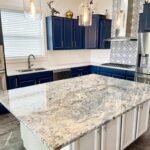When you’re building a sound system, a good 3-way passive crossover can be the difference between just hearing the music and truly experiencing it. If you’ve ever wondered how to improve your speaker setup for more clarity, balance, and richness, then the under 150 W JBL 3 way passive crossover might just be the perfect solution.
In this article, we will take a deep dive into the world of crossovers, focusing on why a JBL 3-way passive crossover with power handling under 150W is an excellent choice for audiophiles and casual listeners alike. We’ll also highlight its key features, technical specifications, and how it fits into different audio setups.
What Is a 3-Way Passive Crossover?
Before we dive into the specifics of the under 150 W JBL 3 way passive crossover, let’s briefly explain what a passive crossover does.
A passive crossover is an electronic component that splits an audio signal into separate frequency bands, directing them to the appropriate speaker drivers (woofers, mid-range, and tweeters). In a 3-way system, the crossover divides the sound into three primary frequency ranges:
- Low frequencies (sub-bass and bass) go to the woofer.
- Mid frequencies (vocals, instruments) go to the midrange driver.
- High frequencies (treble) go to the tweeter.
By using a 3-way system, you ensure that each speaker driver only handles the frequencies it’s designed for. This results in clearer, more accurate sound with less distortion.

Why Choose an Under 150W JBL 3-Way Passive Crossover?
The under 150W JBL 3-way passive crossover is an excellent choice for those who want to fine-tune their sound system while keeping things manageable in terms of power handling. JBL has been a trusted brand in the audio industry for decades, and their crossovers are no exception. Let’s take a closer look at why this particular model is worth considering.
1. Compact and Efficient Power Handling
With a power rating of under 150W, this crossover is ideal for smaller to medium-sized speaker systems. While it may not be suited for extremely high-powered setups, it’s perfect for home theater systems, studio monitors, and even outdoor setups where you don’t need excessive wattage.
The under 150W JBL 3-way passive crossover is designed to ensure that each speaker driver receives the correct frequency range without overloading. This efficiency helps prevent distortion and ensures a clean, natural sound.
2. JBL Quality
JBL is synonymous with quality audio equipment. Whether you’re using JBL speakers or pairing their crossovers with third-party systems, you can trust their engineering to deliver high-quality sound. JBL’s passive crossovers are built with durable components and are engineered to handle audio signals efficiently. If you’re already invested in JBL speakers, using a JBL 3-way passive crossover ensures better synergy across your entire audio system.
3. Improved Sound Clarity
When you use a 3-way crossover, you’re ensuring that the bass, midrange, and treble are being handled by the appropriate speaker driver. The under 150W JBL 3-way passive crossover ensures that each driver performs at its best. By dividing the frequencies efficiently, the crossover enhances the clarity and detail in your audio, making the sound more immersive.
4. Flexibility and Versatility
One of the best features of the under 150W JBL 3-way passive crossover is its flexibility. Whether you’re building a new sound system or upgrading an existing one, this crossover works well with various speaker configurations. It’s a great choice for those looking to add more dimension to their sound without going overboard on power.
5. Affordability
Compared to active crossovers or higher-wattage models, a JBL 3-way passive crossover under 150W is an affordable option that delivers great value for the money. You don’t have to break the bank to improve your sound system. For casual listeners and audio enthusiasts on a budget, this crossover is an ideal choice to enhance their listening experience.

Key Features and Specifications of the Under 150W JBL 3-Way Passive Crossover
Let’s break down some of the important technical aspects of the under 150W JBL 3-way passive crossover:
- Power Handling: 150W or less, ideal for home and medium-scale systems.
- Frequency Range: Divides the signal into low, mid, and high frequencies.
- Crossover Points: Typically ranges from 80Hz for the low-frequency driver, around 1.5kHz for the midrange, and up to 20kHz for the tweeter.
- Impedance: Usually designed for 8-ohm or 4-ohm speaker systems, depending on your setup.
- Construction: Made with high-quality inductors, capacitors, and resistors to ensure minimal signal degradation.
- Size: Compact and lightweight, making it easy to integrate into your speaker system.
These specs make the under 150W JBL 3-way passive crossover suitable for a wide range of applications, from home audio setups to semi-professional use.
How to Set Up the Under 150W JBL 3-Way Passive Crossover

Setting up the under 150W JBL 3-way passive crossover is relatively straightforward, but it’s important to make sure you do it correctly for the best sound quality. Here’s a basic guide:
- Connect the Inputs: The crossover will have a set of inputs where you will feed the full-range audio signal from your amplifier or receiver.
- Connect the Outputs to the Speakers: There will be separate outputs for the low, mid, and high frequencies. These outputs should be connected to the corresponding speaker drivers (woofer, midrange, and tweeter).
- Adjust the Crossover Settings: Some models of crossovers allow you to adjust the frequency points for each range. Set the low-pass filter to suit your subwoofer (usually around 80Hz), the bandpass filter for the midrange drivers, and the high-pass filter for your tweeters.
- Fine-tune the System: Once everything is connected, turn on your system and test the sound. You may need to adjust the levels or fine-tune the crossover points to achieve the best sound balance.
Conclusion
The under 150W JBL 3-way passive crossover is an excellent choice for anyone looking to upgrade their sound system without the complexity of active crossovers or excessive power handling. It offers an affordable, efficient, and high-quality solution for creating a more balanced and immersive soundstage. Whether you’re building a home theater system, setting up studio monitors, or looking for better audio performance in your car or outdoor system, this JBL crossover provides everything you need.
So, the real question is: How much more immersive could your audio experience be with the right crossover in place?











